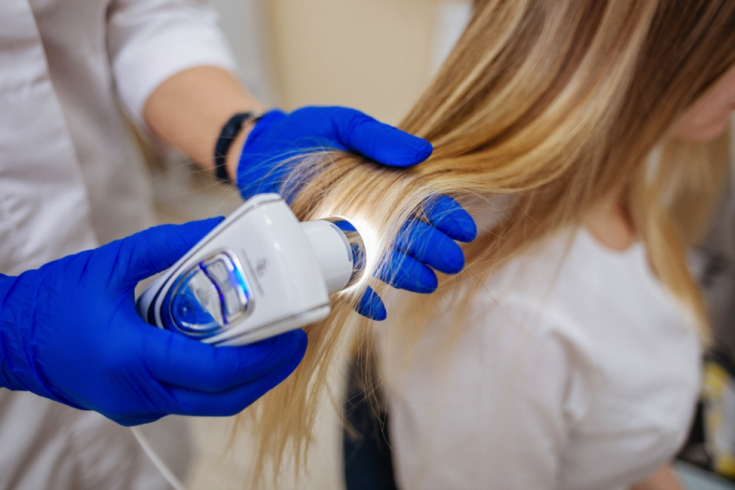The frequency of problems caused by disturbance of the condition of the hair and scalp, according to various sources, varies from 30% to 70% among men and from 45% to 90% among women. As you know, alopecia – it is pathological hair loss and insufficient growth of new ones.
Most cases of hair loss are subclinical. This pathology significantly impairs the quality of life. When a patient contacts a dermatologist, the doctor conducts research to find out the cause and find a way to solve the problem. For this purpose, trichoscopy.
Read more at estet-portal.com benefits and value of trichoscopy in diagnosis.
- What allows you to evaluate the research method in dermatology - trichoscopy
- Main forms and prevalence of alopecia
- Technique and importance of trichoscopy as a research method
What allows you to evaluate the research method in dermatology - trichoscopy
In the practice of a dermatologist, for assessment of the condition of the skin of the scalp of the head and hair, different methods are used. These are examination, anamnesis, clinical objective examination, questionnaire, hair tension and washing tests, trichoscopy, phototrichogram, biopsy, on the basis of which it is possible to diagnose a pathological condition with a high probability and find the cause
diseases of the hair and scalp. The term trichoscopy was coined in 2006 to refer to dermatoscopy on this area of the head.
The essence of the method is to obtain a magnified image for an accurate assessment of the condition of the hair shafts and follicles, interfollicular areas of the skin, as well as the vascular response using lenses of different sizes.The connection of the trichoscope to a computer allows
storing and processing the results in special programs in order to assess the density of the hairline, the number and diameter of the hair shafts, to calculate the ratio of the terminal hair and follicles at different stages. The programs also allow you to compare the patient's performance with the norms.
Read also: Diffuse alopecia: why it is difficult to treat
According to the literature,trichoscopy indicators significantly increase the accuracy of clinical diagnosis and differential diagnosis of various pathological conditions. To a greater extent this applies to alopecia.
Main forms and prevalence of alopeciaAccording to the clinical classification,
scarring and non-scarring forms of alopecia are distinguished, the diagnosis of which requires trichoscopy.
The cicatricial forms include alopecia with such pathologies:
- discoid lupus erythematosus;
- frontal fibrous alopecia;
- lichen planus;
- centrifugal cicatricial alopecia;
- Folliculitis decalvans.
Facebook!
Non-scarring forms include:
- diffuse hair loss;
- alopecia areata; androgenetic alopecia.
Androgenetic alopecia is the most common form of alopecia, occurring throughout life in 80% of men and in half of women.
Methodology and significance of trichoscopy as a research methodTrichoscopy can be performed at the first visit to the doctor, preparation for it is not required. Trichoscopy consists of a step-by-step examination of the scalp
with a special sensor that transmits the data obtained to the computer screen. The procedure is absolutely safe and harmless and takes no more than half an hour. During trichoscopy, the integrity of the skin is not violated, the structure of the hair is not disturbed.

A
study was conducted, in which the trichoscopic picture was evaluated in 30 patients with non-scarring alopecia and papulo-squamous dermatoses of the scalp, differential diagnosis of these pathological conditions was carried out.
You will also be interested in: What you need to know about the hair follicle: morphogenesis, structure and regeneration of hair
Specific trichoscopy criteria made it possible to confirm in 93.5%, and in 2 patients to change the clinical diagnosis, which indicates the high diagnostic capabilities of trichoscopy, as well as its advantage over a simple clinical examination.Identification of special
trichoscopic signs allows a deeper understanding and evaluation of the pathogenetic and clinical course of the pathological process. Therefore, trichoscopy should be included in the examination plan of the patient in the daily practice of a dermatologist and trichologist. It is also important for patients who have complaints of scalp problems to have trichoscopy, as most pathological processes of the hair follicles can be detected in the early stages.
Watch our videos onYouTube-channel:







Add a comment